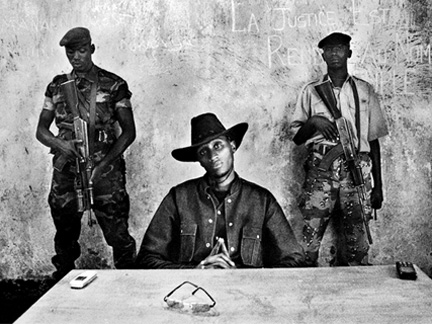shortlisted webdocumentary
Condition critical: voices from the war in eastern Congo
Article published on the 2009-08-18 Latest update 2009-08-26 14:13 TU
Cédric Gerbehaye was back in the Democratic Republic of Congo (DRC) ahead of this year's Visa pour l'image. He explained from Kinshasa that the webdocumentary Voices from the war in Eastern Congo began because, it seemed to him, the fighting was absent from the media.
"I suggested to Médecins Sans Frontières (MSF) that I produce a webdocumentary - or a multimedia - to try and attract attention to the conflict", Gerbehaye said from Kinshasa.
He did the on-the-ground work in three stages: Summer 2007, December 2007 and Summer 2008. He worked with the different divisions of MSF - MSF France, MSF Belgium, MSF Spain, MSF Holland - while collecting much of his material.
This, he says, allowed him access to places that he wouldn't ordinarily have been able to get to. "I worked mainly in Ituri and in Nord Kivu and I worked in Masisi," he says. "The thing, in the east of the DRC, is the difficulty in communications and in travelling".
"We decided to make a webdocumentary just before the third trip," he says, explaining that MSF sent a second person to shoot the video and another to record sound.
Voices from the war in Eastern Congo uses photos, black & white video, colour video, and audio testimonies. "What was important for us was to tell the story," he says, "so if something didn't contribute to the story - if it was just a beautiful image or a nice sound recording - it wasn't used".
As well the main report, the site incorporates a photo timeline of the conflict, personal eyewitness accounts and reaction from people to the material in the webdocumentary.
Gerbehaye's documentary was produced in several languages which, he says, lets as many people as possible find out about fighting in the east of the DRC.
The project was launched last November, at a time when the conflict in the east of the DRC was making it into the news because of the advance of Laurent Nkunda's CNDP.
Media organisations began sending people on a temporary basis to report on the situation. "When people go to the Congo, they make reports, they explain the situation and every so often they take a few small words of testimony".
He says that what they wanted to do in the webdocumentary was to give the Congolese the space to express themselves.
Since he was working with two other people, who were taking the audio and the video, he wasn't loaded down with material or wearing several different journalistic hats.
"It's possible to do it", he says, when asked if one journalist can do everything.
"The question is whether you lose something in each of the media by increasing the number of them or if, in fact, adding these different media together brings more to the report".
Decide for yourself at Voices from the war in Eastern Congo.






